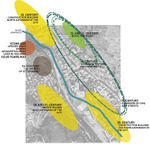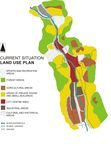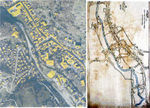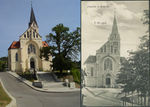Green Infrastructure 2014 Group N - Case Study 3
---> back to group page working group N
'''== Kapinica River, Krapina city, Croatia =='''
| Name | Kapinica River | |
| Country | Croatia | |
| City | Krapina | |
| Authors | Mateja Leljak | |
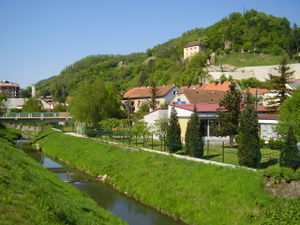
| ||
|
| ||
Rationale: Why is this case interesting?
Please explain in short why this site has green infrastructure potential and what makes it special (150 words approx)
Author's perspective
what is your professional/educational background and your relation to the site?
Landscape and/or urban context of Krapina-Zagorje County and Krapina city
KRAPINA-ZAGORJE COUNTRY
Krapina-Zagorje County is a county in northern Croatia. It encompasses most of the historic region called Hrvatsko Zagorje. The Krapina-Zagorje County is a candidate for being the most idyllic county in Croatia: the many villages and small towns spread out across the hillsides are perfect for agriculture (vineyards in particular) and summer houses.
The Krapina-Zagorje County borders on the Varaždin County in the northwest, Zagreb County in the southwest and southeast, and the city of Zagreb in the south.
County seat of Krapina-Zagorje County: KRAPINA
Area: 1,229 km2 (475 sq mi)
Population (2011) : 132,892 / 110/km2 (280/sq mi)
Area code: 049
ISO 3166 code: HR-02
KRAPINA – the centre of Krapina-Zagorje County
Krapina is today the cultural, political and administrative centre of Krapina-Zagorje County and it is the largest region in Hrvatsko zagorje. It is located approximately 55 km (34 mi) from the Croatian capital city Zagreb. This is a place of many hills, rivers, creeks and lakes through many valleys.
Area: City_47.53 km2 (18.35 sq mi) // Elevation_203 m (666 ft)
Population (2011): City_12,479 // Densty_260/km2 (680/sq mi) / Urban_4,482
History
Perhaps the most astonishing landmark of the area is the excavation site of a 125,000 year old Neanderthal man in caves near the central town. The fact that Krapina is the political centre of the county has historical roots. Krapina County (comitatus crappinensis) was mentioned as early as 1222 in the 1222 charter of Duke Béla where prince Petar of Krapina was named the head of the Croatian noble parish (Petar “comes de Crapuna”). King Sigismund of Croatia and Hungary, who owned an estate in Krapina (Castrum Carpone), awarded the mayor of the town of Krapina the title of the Great Count of Zagorje County in 1399. During the administration of ban Ivan Drašković, five sessions of the Croatian Parliament were held in Krapina at the turn of the 17th century. Ante Starčević, the Father of the Nation, and bishop Juraj Strossmayer, signed political agreements in Krapina that defended Croatia’s interests.
Culture
Krapina is a home to yearly Festival kajkavske popevke (The festival of kajkavian song) sung in the local Kajkavian dialect. At the site where the Neanderthals remains were discovered there is now a state of the art Neanderthal museum which also includes an extensive segment on evolution, making it one of the most interesting evolutionary museums in Europe. It is surrounded by a park with many statues of Neanderthals and their game, a bear, a moose and a beaver set in the actual locations. There is also a nearby municipality of Krapinske Toplice (Krapina spa) with numerous thermal springs and spa tourist infrastructure. Krapina is also the birthplace of the linguist and language reformer Ljudevit Gaj. His home is now a museum where visitors can learn about his life and work.
Industry
The main industrial branches are textiles and garments, production of housing containers and potassium stoves, Styrofoam, wiring supplies from plastic material, and construction industry specialized in the restoration of classical buildings with a large share of a craftsman works. A new business and trade centre will also be opening soon in Krapina; the town offers not only trade but also intellectual services, including marketing and project management firms, legal and financial services, medical and dental services, as well as many personal services such as hairdressing, pedicures, beauty salons, photography, photocopying shops, laundry services etc.
- Illustrations: maps; sketches; short descriptive analyses
- Illustrations
Analytical drawings
- Please use analytical drawing for visualising the conflicts/potentials of your site
- Analytical Drawings
- Your drawing.jpg
your drawing
- Your drawing.jpg
your drawing
- Your drawing.jpg
your drawing
- Your drawing.jpg
your drawing
Green Infrastructure benefits for this site
Look again at the multiple benefits of green infrastructure - what could be achieved in your site and which are most relevant?
Potential for multifunctionality
Green infrastructure has typically multiple functions. What could be achieved for your site in this respect?
Projective drawings
- How would you like this case to change in the near future? (in 1-2 years)
- you may add a short explanation here
- And how could it look like in 10-15 years?
- you may add a short explanation here
- Projective Drawings
- Yourdrawing.jpg
projective drawing
- Yourdrawing.jpg
projective drawing
- Yourdrawing.jpg
projective drawing
Summary and conclusion
- 100 words approx.
Image Gallery
Please add further images/photos here
- Image Gallery
References
- please add your references here
About categories: You can add more categories with this tag: "", add your categories

